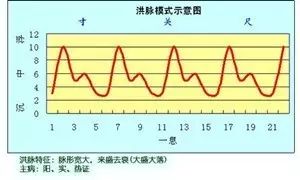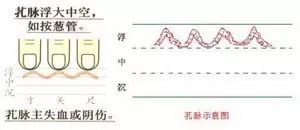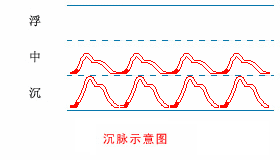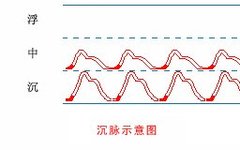Editor’s Note
|
In the article “Discussing the Six Basic Pulse Types in TCM”, we learned that pulse types are divided into six categories: floating, deep, slow, rapid, weak, and strong. These six pulses are also known as pulse classifications, as they reflect some fundamental factors. Based on variations in pulse shape, force, and frequency, these pulse classifications can be further subdivided, indicating different primary diseases. This article introduces various pulse manifestations of floating and deep pulses.
The floating pulse includes six types: fu (浮), hong (洪), ru (濡), san (散), kao (芤), and ge (革), characterized by a superficial pulse position that can be easily felt with light pressure. The deep pulse includes four types: chen (沉), fu (伏), lao (牢), and ruo (弱), which are located deeper and require heavier pressure to be felt. What do these different pulse types signify in terms of disease? |
Floating Pulse Types
Floating Pulse
The floating pulse is a single-factor pulse type with independent significance. It is primarily characterized by a superficial pulse position that is most evident with light pressure, while medium or deep pressure yields little or no pulse sensation.
The floating pulse is defined by its location, which is superficial, situated “on the flesh”, and does not involve other factors, contrasting with the medium and deep pulses that have different depths. The sensation of the floating pulse is light and easily felt; it is prominent with light pressure but diminishes with heavier pressure. With light pressure, the shape of the pulse vessel is clear and the pulsation is distinct; with heavy pressure, the pulse vessel is compressed, and the pulsation weakens. Metaphors for the floating pulse include “like wood floating on water”, “like objects floating on water”, “the meaning of floating wood”, “like following the elm pods”, and “like hair blown by the wind”.
The floating pulse is one of the primary pulse types, and based on it, various derived pulse manifestations can be formed by adding related factors. There are many variations of the floating pulse, including fu shuo (浮数), fu huan (浮缓), fu chi (浮迟), fu jie (浮结), fu xi (浮细), fu hong (浮洪), fu dong (浮动), fu duan (浮短), fu hua (浮滑), fu se (浮涩), fu jin (浮紧), fu xian (浮弦), fu san (浮散), fu ru (浮乳), fu ruo (浮弱), fu xu (浮虚), fu er you li (浮而有力), fu er wu li (浮而无力), fu hong da (浮洪大), fu ruo se (浮弱涩), fu xi hua (浮细滑), fu jin hua (浮紧滑), fu hua ji jin (浮滑疾紧), fu hua shuo ji (浮滑数疾), fu hong da chang (浮洪大长), fu da xian ying (浮大弦硬), etc.
The floating pulse appears in individuals with a normal pulse (thin people, autumn season, lung pulse), indicating a disease on the surface, with the evil in the yang aspect, primarily indicating wind evil. It can also indicate internal deficiency, particularly in women during childbirth. In summary, the floating pulse can arise from superficial blood vessels, seasonal factors, invasion of surface evil, internal deficiency leading to blood loss, qi deficiency causing floating pulse, and excessive yang qi leading to floating pulse.
Hong Pulse

The hong pulse is a single-factor pulse type with independent significance, characterized by a large pulse body. It is generally considered that the large pulse, hook pulse, and hong pulse are the same.
The hong pulse has a large pulse body, and its metaphors include “the flood of water”, “the vastness of rivers”, “the surging waves”, “coming strong and going weak”, “overflowing to the fingertips”, “like a string of pearls”, “like following the sound of a bell”, etc.
The hong pulse is one of the primary pulse types, and based on it, various derived pulse manifestations can be formed by adding related factors. Variations of the hong pulse include fu hong (浮洪), chen hong (沉洪), hong shuo (洪数), hong da (洪大), hong hua (洪滑), etc.
The hong pulse is primarily seen in individuals with a normal pulse, excess yang heat accumulation, taiyang surface syndrome, yin deficiency with blood loss, and yin-yang disharmony. In summary, the hong pulse can appear due to internal excess heat, rising qi and blood, yin blood deficiency, floating yang, and summer heat affecting the heart pulse.
Ru Pulse
The ru pulse is a composite pulse type. It is characterized by floating, fine, weak, and soft features.
Descriptions of the ru pulse are numerous, with metaphors such as “like silk in water”, “like pressing cotton in water”, “like pressing floating cotton”, “like cotton floating in water”, “like silk floating on water”, “like foam floating on water”, “like floating fluff on the water surface”, “like fine threads”, “like floating cotton in water”, etc. Descriptive language for the ru pulse includes “floating fluff on the water surface cannot be held”, “scattered and fine, like cotton floating in water, lightly felt, but disappears with heavier pressure”, “seems to be there when searching with fingers, but disappears when pressed”, “quickly fades away”, “vanishes with a light touch”, “weak and unresponsive”, etc., which can aid in understanding.
Due to the multiple characteristic factors of the ru pulse, there are few variations, such as ru ruo (濡弱) pulse.
The ru pulse is primarily seen in individuals with a normal pulse, qi deficiency, blood loss injuring yin, yin and yang deficiency, dampness syndrome, and bi syndrome. In summary, qi and blood deficiency, dampness obstructing qi mechanism, and relaxed and unrestrained pulse can lead to the ru pulse.
Kao Pulse

The kao pulse is a composite pulse type. It is characterized by floating, large, soft, and hollow features.
Metaphors used to understand the kao pulse include “flowing water not connecting”, “like the shape of spilled lacquer”, “like scallions”, “like pressing scallions”, “like pressing scallion tubes”, “similar to scallions”, “the kao leaf is similar to scallions”, “pressing it feels like twisting scallion leaves”, etc., with the metaphor of “scallions” being the most common.
The kao pulse is a composite pulse that is not commonly seen in clinical practice. Due to the multiple characteristic factors of the kao pulse, there are few variations, and classical texts often record variations of the kao pulse reflecting changes in specific prominent characteristic factors. Variations of the kao pulse include fu kao (浮芤), kao da (芤大), xū kao (虚芤), kao se (芤涩), etc.
The kao pulse is primarily seen in cases of sudden massive blood loss, but can also appear in blood deficiency, loss of essence, intestinal abscess, and abscess rupture.
The kao pulse is a pulse type that is internally truly deficient but appears externally solid. Sudden massive blood loss leads to insufficient blood within the pulse vessel, resulting in a hollow sensation; yin and yang cannot support each other, qi has no place to return, and the excessive yang qi pushes outward, leading to a floating pulse position, a large pulse body, and a solid edge. This is the main mechanism for the formation of the kao pulse.。
[Appendix] San and Ge Pulses
San Pulse
[Pulse Type] The san pulse is floating and scattered without a root, with an irregular frequency. Its characteristics include floating and scattered sensation, seeming absent in the middle phase, unresponsive in the deep phase, and often accompanied by irregular pulsation, sometimes fast and sometimes slow, but without obvious pauses, or it may present as inconsistent pulsation strength. Therefore, the san pulse is a floating pulse without a root, described by ancient texts as “scattered like willow catkins without a fixed trace”.
[Main Disease] Dispersed vital energy, critical conditions of organ qi and essence decline.
[Pulse Mechanism] The san pulse often results from qi and blood deficiency, essence energy depletion, yin failing to restrain yang, and dispersed yang qi, leading to an inability of the pulse qi to gather and consolidate.
Ge Pulse
[Pulse Type] The ge pulse is floating and beats against the fingers, hollow on the inside but firm on the outside, like pressing on a drum skin. Its specific characteristics include a large and hard pulse sensation with a strong beat when lightly pressed, but weak when pressed harder, giving a feeling of hollowness, resembling pressing on a taut drum skin.
[Main Disease] Blood loss, loss of essence, postpartum conditions, and leakage.
[Pulse Mechanism] Due to the depletion of essence and blood, the pulse vessel is not filled, and the vital energy is not stable, leading to a floating and large pulse that beats strongly but is hollow inside, resembling a taut drum skin.
Deep Pulse Types
Deep Pulse

The deep pulse is a single-factor pulse type with independent significance, containing no other factors. It is primarily characterized by a deep pulse position, which is more evident with heavy pressure than with medium or light pressure. The deep pulse is defined by its location, which is deep, close to the tendons and bones, situated “beneath the muscles”, and has a tendency to sink deeply, contrasting with the floating and medium pulses that have different depths.
The sensation of the deep pulse is felt with heavy pressure, while it is less evident with lighter pressure. With heavy pressure, the shape of the pulse vessel is clear and the pulsation is distinct; with light pressure, the pulsation strength diminishes. Metaphors for the deep pulse include “like a stone sinking in water”, “like a stone sinking”, “like a stone falling to the bottom”, “like cotton wrapped in sand”, etc.
The deep pulse is one of the primary pulse types, and based on it, various derived pulse manifestations can be formed by adding related factors, and it can also combine with related pulse types to form variations. There are many variations of the deep pulse, including chen fu (沉伏), chen shuo (沉数), chen chi (沉迟), chen jie (沉结), chen huan (沉缓), chen xi (沉细), chen xiao (沉小), hua (滑), chen se (沉涩), chen ru (沉乳), chen shi (沉实), chen ruo (沉弱), chen xian (沉弦), chen jin (沉紧), chen lao (沉牢), chen er you li (沉而有力), chen er wu li (沉而无力), chen xian jin (沉弦紧), chen jin shuo (沉紧数), chen xiao chi (沉小迟), chen xi shuo san (沉细数散), etc.
The deep pulse can appear in individuals with a normal pulse, indicating a disease on the surface, with a nature of yin, located internally, indicating cold, phlegm, dampness, retained food, qi disease, emotional injuries, and pain. In summary, hidden qi and blood, seasonal factors, phlegm and food qi, and other excess conditions, as well as organ deficiency leading to insufficient vital energy, can all lead to a deep pulse.
[Appendix] Fu, Ruo, and Lao Pulses
Fu Pulse
[Pulse Type] Felt with heavy pressure on the tendons and bones, may be absent in severe cases.
[Main Disease] Evil closure, critical conditions, severe pain.
[Pulse Mechanism] Due to the internal lurking of evil qi, the pulse qi cannot circulate, and the pulse path becomes hidden and unresponsive, resulting in the fu pulse; if yang qi is weak and about to collapse, the pulse may also present as fu. The former is often seen in acute evil diseases, while the latter is more common in chronic diseases with declining vital energy.
Ruo Pulse
[Pulse Type] Extremely soft and deep.
[Main Disease] Deficiency of qi, blood, yin, and yang.
[Pulse Mechanism] Insufficient yin blood cannot fill the pulse path, and weak yang qi cannot effectively promote blood circulation, resulting in a soft and deep pulse, forming the ruo pulse.
Lao Pulse
[Pulse Type] Deep, firm, large, and long, solid and immovable.
[Main Disease] Yin cold accumulation, internal solid masses.
[Pulse Mechanism] The formation of the lao pulse is due to the solidification of pathogenic qi, internal accumulation of yin cold, and the sinking of yang qi, resulting in a deep, solid, large, and long pulse that is firm and immovable. The lao pulse indicates the presence of solid qi and blood, with palpable masses indicating solid blood; while intangible masses indicate solid qi. If the lao pulse is seen in cases of blood loss or yin deficiency, it indicates a critical condition of sudden blood loss.
|Author Introduction|
Yang Jie, female, Chief Physician at the China Academy of Chinese Medical Sciences, Doctor of Medicine, Postdoctoral Fellow. She has published over ten academic papers and authored a series of books including “Secret Recipes for Cancer Treatment”, “Dietary Therapy for Cancer”, and “Chinese Herbal Medicine for Cancer”.
Source: China Modern Distance Education of Traditional Chinese Medicine, images from the internet/Edited by: Muzi

» If you find this article valuable, pleaseshare it with your friends!
|
One article a day, sharing secrets for nourishing the heart, body, and spirit. TCM treasures, there must be a “treasure” suitable for you! |
Click“Read the original text”, discover more exciting content……
↓↓↓

